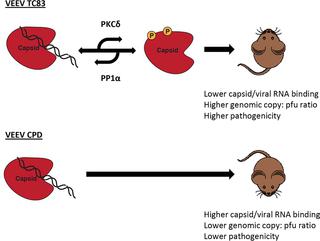PLoS Pathogens ( IF 5.5 ) Pub Date : 2020-03-09 , DOI: 10.1371/journal.ppat.1008282 Brian D Carey 1 , Ivan Akhrymuk 1 , Bibha Dahal 1 , Chelsea L Pinkham 1 , Nicole Bracci 1 , Sarah Finstuen-Magro 1 , Shih-Chao Lin 1 , Caitlin W Lehman 1 , Kevin J Sokoloski 2 , Kylene Kehn-Hall 1

|
Protein phosphorylation plays an important role during the life cycle of many viruses. Venezuelan equine encephalitis virus (VEEV) capsid protein has recently been shown to be phosphorylated at four residues. Here those studies are extended to determine the kinase responsible for phosphorylation and the importance of capsid phosphorylation during the viral life cycle. Phosphorylation site prediction software suggests that Protein Kinase C (PKC) is responsible for phosphorylation of VEEV capsid. VEEV capsid co-immunoprecipitated with PKCδ, but not other PKC isoforms and siRNA knockdown of PKCδ caused a decrease in viral replication. Furthermore, knockdown of PKCδ by siRNA decreased capsid phosphorylation. A virus with capsid phosphorylation sites mutated to alanine (VEEV CPD) displayed a lower genomic copy to pfu ratio than the parental virus; suggesting more efficient viral assembly and more infectious particles being released. RNA:capsid binding was significantly increased in the mutant virus, confirming these results. Finally, VEEV CPD is attenuated in a mouse model of infection, with mice showing increased survival and decreased clinical signs as compared to mice infected with the parental virus. Collectively our data support a model in which PKCδ mediated capsid phosphorylation regulates viral RNA binding and assembly, significantly impacting viral pathogenesis.
中文翻译:

蛋白激酶C亚型δ与委内瑞拉马脑炎病毒衣壳蛋白相互作用,并通过调节衣壳磷酸化来调节病毒RNA结合。
蛋白质磷酸化在许多病毒的生命周期中起着重要作用。委内瑞拉马脑炎病毒(VEEV)衣壳蛋白最近被证明在四个残基处被磷酸化。在这里,这些研究扩展到确定负责病毒生命周期中磷酸化的激酶和衣壳磷酸化的重要性。磷酸化位点预测软件表明蛋白激酶C(PKC)负责VEEV衣壳的磷酸化。VEEV衣壳与PKCδ共免疫沉淀,但未与其他PKC亚型共免疫沉淀,而PKCδ的siRNA敲低导致病毒复制减少。此外,siRNA敲低PKCδ降低了衣壳磷酸化。具有衣壳磷酸化位点突变为丙氨酸的病毒(VEEV CPD)显示出比亲本病毒更低的基因组拷贝与pfu比率;提示更有效的病毒组装和更多的传染性颗粒被释放。RNA:衣壳结合在突变病毒中显着增加,证实了这些结果。最后,VEEV CPD在感染小鼠的模型中被减弱,与感染亲本病毒的小鼠相比,小鼠显示出增加的存活率和降低的临床体征。我们的数据共同支持一个模型,其中PKCδ介导的衣壳磷酸化调节病毒RNA的结合和装配,从而显着影响病毒的发病机理。与感染了亲本病毒的小鼠相比,小鼠的存活率提高了,临床体征降低了。我们的数据共同支持一个模型,其中PKCδ介导的衣壳磷酸化调节病毒RNA的结合和组装,从而显着影响病毒的发病机理。与感染了亲本病毒的小鼠相比,小鼠的存活率提高了,临床体征也降低了。我们的数据共同支持一个模型,其中PKCδ介导的衣壳磷酸化调节病毒RNA的结合和装配,从而显着影响病毒的发病机理。











































 京公网安备 11010802027423号
京公网安备 11010802027423号